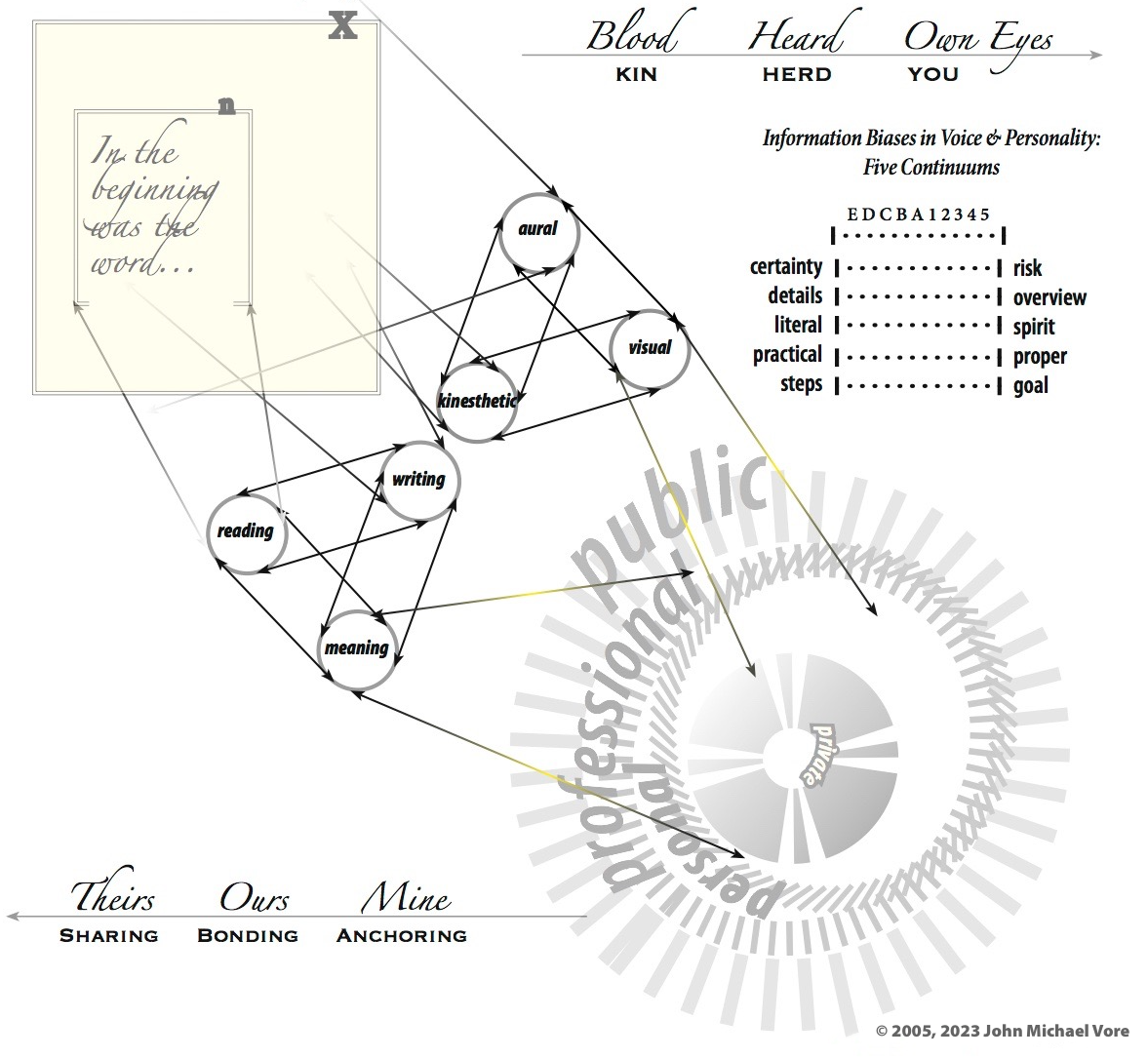Introduction - Reading, Writing, Meaning
 |
| Illustration: a map/diagram of the elements of this approach to teaching reading, writing and meaning. (2005, John Michael Vore) |
READING, WRITING, MEANING BLOG : INTRODUCTION
by John Michael Vore
This blog created in Fall 2023 for two sections of Reading, Writing, Meaning, a first-year university writing course taught in the United States in an area known as the Midwest. It includes notes, diagrams and hand-outs related to the course--and student contributions (with their permission). This first entry is called "Reading, Writing, Meaning Blog: introduction."
The "Reading, Writing, Meaning" blog is dedicated first to the unwilling students of writing, who find themselves in a required writing course (it is a good thing to require). They don't like writing. I've (sometimes) taught them writing. Given that students expressly make up part of the audience of this blog, there will be occasional notes aimed at them. Example: "Note: This page has artwork, a title, a byline, body, an annotated reference section (and a blog design section)." (The example, itself, applies.) Typically a subject is the sole focus of a paper (or its equivalent here, a blog entry); diversions from the direction of the goals laid out in the introduction get special notices. Blogs offer links out of the paper's direction, information which used to be held in footnotes or endnotes (and which show up here as annotated references at the bottom of the page).
This blog is also dedicated to teachers of writing at all levels, who know that good writing can be evidence of a mind at work, even if not always the best evidence of even the best minds. When we do a great job, however you organize the experiences of your life, you'll have learned how to get some of that onto a written page merely because you want it there.
One way to teach writing is to imagine it first as a way of organizing words. One can make word lists and diagrams and use writing in sentences. In many ways writing longer form (more than a few paragraphs) means linking similar ideas, generally grouped together in paragraphs. One can do some of the complicated work of organizing one's ideas through lists and diagrams--not pretending one's thoughts must end up in something that mimics writers. Eventually, however one does the meta work of organizing worded thoughts, the aim for us is to end up writing.
Yet all speech and most writing starts out as mimicry--us writing down things we've heard others say, what we've read. For this reason I often start out by talking about the myth of Echo and Narcissus. (One of the best ways of come across which describes the myth is by Louise Vinge, here. More about that in another blog entry.) Let us take instruction from an earlier master at the craft of writing, Ovid: don't get caught up in repeating everything you hear, don't get stuck obsessed on one thing, elevate your game. Do the thing which can include Echo & Narcissus: writing, itself.
The myth inspired me to see writing in those constituent parts and its sensory parts. I illustrated some of these and other elements about teaching writing in the diagram at the top of this page.
My approach to Reading, Writing and Meaning shows some of the ways in which it relies on research in cognitive neuroscience. A worded description of the illustration: from the top left, a representation of a page, then a model of how information gets organized by a mind intent on writing, and then how different ideas find themselves filtered by areas of meaning--not necessarily in that order. In short, reading, writing and meaning.
Annotated References
Hurlburt, Russell. "Pristine Inner Experience. Psychology Today. October-November 2011. Found online 14 November 2023: https://www.psychologytoday.com/us/blog/pristine-inner-experience
-links to a series of articles by Russell Hurlburt, PhD, about his methods of discovering "pristine inner experience," that is, experience of one's self not dependent on prior ideological authorizations (so to speak)
Vinge, Louise. "The Narcissus theme in Western Western European Literature up thru the early 19th century." Found online 14 November 2023. https://archive.org/details/narcissusthemein0000ving
-links to an archive.org version of the book, Vinge's PhD thesis from 1969. I repeatedly insist on this as a great source about the myth because it ostensibly stops before Sigmund Freud and others utilized the myth in Western psychiatry
Vore, John Michael. Poster. "Information Flows Through Mirrored Triangularities: The Aural-Visual-Kinesthetic Grasp & The Reading-Writing-Meaning Triangle." Undelivered talk. 2005.
Wikipedia. "Blog." Found online 14 November 2023: https://en.wikipedia.org/wiki/Blog
-links to Wikipedia entry which defines a blog and gives its history
Wikipedia. "Midwest." Found online 14 November 2023: https://en.wikipedia.org/wiki/Midwestern_United_States
-links to Wikipedia entry which defines a blog and gives its history
Blog Layout
Headline: 24 pt., bold, Large, default font
Section: 18 pt., bold, Medium, default font
Byline: 18 pt., Medium regular, default font
Body: 16 pt., Normal regular, default font; single space paragraphs, double space in between
Comments
Post a Comment